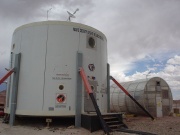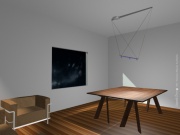Mars Analogue Research Station Program
Da Ufopedia.
(Creata pagina con 'The '''Mars Analog Research Station Program''' (MARS) is an international effort spearheaded by The Mars Society to establish a network of prototype research centers [[Human ...')
Differenza successiva →
Versione delle 12:27, 11 ott 2013
The Mars Analog Research Station Program (MARS) is an international effort spearheaded by The Mars Society to establish a network of prototype research centers where scientists and engineers can live and work as if they were on Mars, to develop the protocols and procedures that will be required for human operations on Mars, and to test equipment that may be carried and used by human missions to the Red Planet.
Indice |
Status
The first station, the Flashline Mars Arctic Research Station (FMARS) began operation in 2000 on Devon Island in the Canadian Arctic. The second station, the Mars Desert Research Station (MDRS) began operation in 2002 in southern Utah. Stations to be built in Europe (European Mars Analog Research Station / EuroMARS) and Australia (Australia Mars Analog Research Station / MARS-Oz) have not progressed beyond the planning stages. EuroMARS was planned for deployment in Iceland. A structure for EuroMARS was built, but placed in storage for several years due to lack of funding to ship to the Society's UK headquarters, and from there on to Iceland. During storage and shipping the structure was damaged beyond repair, so now the European chapters of the Mars Society are seeking funding to build a new habitat. The fourth station, MARS-Oz, has been designed, but lacks funding for construction.
Each of the MARS research centers comprises a prototype of the Mars Habitat Unit of the kind advocated in the Mars Direct and NASA Mars Design Reference Mission for sending human crews to Mars.
These are multi-deck units, providing a combination of living and working space for crews of up to 6 people at a time. Each unit is approximately Template:Convert in diameter and stands Template:Convert in height, offering either two or three decks of interior living and working space.
Layout
The Flashline Mars Arctic Research Station (FMARS) and the Mars Desert Research Station (MDRS) are two-deck units, designed around a common layout.
The upper deck is divided into two halves: one is given over to six individual sleeping cabins that provide visiting crew members with a bed, personal storage space and privacy when they need it. The other half of the upper deck is devoted to a common work area / dining area / food preparation area. In the ceiling space above this is the unit's large water tank, containing all of the habitat's usable water (this is resupplied from an additional tank outside of the unit. However, on a real mission, the water would be recycled after use, and possibly augmented by water obtained via extraction from the Martian permafrost).
The lower deck contains an open-plan work area where a variety of science and engineering tasks can be performed. It also contains the main hygiene area (toilet, washbasin and shower), and contains the main power distribution system for the habitat and the heating system. Heat and power are supplied by external generators, but on a real mission to Mars they would most likely be supplied using a combination of nuclear and possibly solar power. However, due to the extremes of dust contamination, solar panels will not supply sufficient energy to power a Habitat on Mars on their own.
Also on the lower deck of the FMARS and MDRS are the airlocks and the Extra-vehicular Activity preparation room (EVA prep room). This is where crew members don and doff their simulated Mars spacesuits prior to leaving the Habitat Unit.
The European Mars Analog Research Station is slightly different from FMARS and MDRS in that it provides three decks:
- The uppermost deck contains sleeping quarters for the 6-person crew, and storage space for on-board systems and / or additional equipment
- The mid-deck provides a dedicated communications centre / solar storm shelter, a galley, exercise area, storage bins and a living / working area, and hygiene facilities
- The lower deck provides two micro laboratories, a main repair / medical treatment area, 2 airlocks and an EVA prep area.
The European unit has been deliberately designed for expansion - additional equipment and technology, such as water recycling systems, can be added to the unit as they become available.
Operational goals
The primary goal of the MARS programme is to research the operational environment of a base on Mars. As such, the programme is specifically geared towards answering a wide range of key questions about living and working on Mars, including:
- What is the best number for an exploratory team on Mars - four people, six people, more?
- How well do support systems and equipment function "in the field"?
- What are the best designs for EVA suits?
- How easy is it to maintain equipment in isolated conditions?
- How are group dynamics going to operate in such a closed environment?
In order to find answers to these and other questions, MARS teams will:
- Perform a wide range of EVA and scientific experiments of the kind that will be performed on Mars
- Test communications equipment, EVA suit designs, portable life support facilities and other elements crucial to a human expedition to Mars
- Learn to conduct extended EVA sorties using vehicles such as unpressurised ATVs and analogues of pressurised rover vehicles that can operate away from the main base for days at a time
- Find out the optimum means of carrying out surface investigations – how many people need to be on an EVA mission in order to make it effective, etc.
In order to achieve these goals, operations at the Habitat Units are performed under "Mars simulation" conditions. This means that once a crew is in a unit, barring a serious medical event or emergency, they live and work as astronauts would on Mars:
- They cannot leave the unit without donning a simulated space suit
- They cannot communicate directly with anyone outside of the unit without a built-in time delay in the communication - the distance between Earth and Mars makes direct conversation impossible
- They can only use the equipment, tools and food available to them inside the habitat.
Each crew spends between 2 weeks and a month living in a habitat unit, performing the kind of work astronauts will be expected to carry out on Mars: collecting rock samples from the surface and examining them back in the habitat; conducting life science experiments; studying the local geology and geomorphology, and so on.
See also
- Australia Mars Analog Research Station
- Colonization of Mars
- Flashline Mars Arctic Research Station
- Mars Desert Research Station

